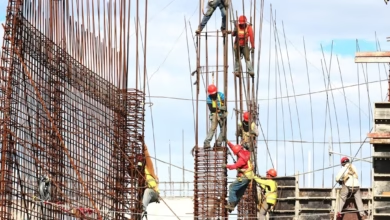Industrial Metals Unveiled: Applications, Trading Insights, and Sustainable Practices for Aluminum, Copper, and Zinc

In today’s rapidly evolving economy, industrial metals play a critical role across various sectors, from construction and automotive to aerospace and energy. Metals such as aluminum, copper, and zinc are essential not just for their structural properties, but also for their versatility in applications ranging from metal alloys to advanced metal fabrication techniques. As the demand for sustainable practices increases, the importance of metal recycling and the transition towards a circular economy are becoming more pronounced. This article delves into the multifaceted world of industrial metals, examining their key applications and characteristics, the trading landscape for base metals, and the innovations in sustainable metal production. We will also explore how trends in metal mining and metallurgy shape investment opportunities, particularly for those interested in diversifying their portfolios with precious metals like gold and silver, as well as energy metals such as lithium and cobalt. Join us as we uncover the dynamic interplay between these vital materials and the market forces that influence their value and availability.
- 1. Understanding Industrial Metals: Key Applications and Characteristics of Aluminum, Copper, and Zinc
- 2. The Trading Landscape for Base Metals: Insights into Market Trends and Investment Opportunities
- 3. Sustainable Metal Production and Recycling: The Future of Industrial Metals in a Circular Economy
1. Understanding Industrial Metals: Key Applications and Characteristics of Aluminum, Copper, and Zinc
Industrial metals play a crucial role in various sectors of the economy, serving as foundational materials for construction, manufacturing, and technology. Among the most significant industrial metals are aluminum, copper, and zinc, each with unique characteristics and applications that make them indispensable.
Aluminum is a lightweight, non-ferrous metal known for its excellent corrosion resistance and high strength-to-weight ratio. This makes it a preferred choice in industries such as aerospace and automotive, where reducing weight can lead to improved fuel efficiency. Additionally, aluminum is highly recyclable, aligning with sustainable metal production practices that minimize waste and energy consumption. Its versatility is further enhanced through metal alloys, which combine aluminum with other elements to enhance specific properties, making it suitable for products ranging from beverage cans to structural components in buildings.
Copper, recognized as one of the base metals, is renowned for its exceptional electrical conductivity and thermal properties. This makes it a vital material in electrical wiring, electronics, and plumbing. The demand for copper is also driven by its role in renewable energy technologies, such as solar panels and electric vehicles, positioning it as a key player in the energy metals sector. Furthermore, copper's antimicrobial properties contribute to its use in various applications, including plumbing fixtures and medical equipment.
Zinc, another important non-ferrous metal, is primarily utilized for galvanization, a process that protects steel and iron from corrosion. This characteristic is essential for construction metals, ensuring the longevity of structures exposed to harsh environmental conditions. Zinc is also a critical component in battery production, particularly in rechargeable batteries, highlighting its importance in the growing field of battery metals. Its role in metallurgy extends to the creation of metal alloys, which enhance the performance of various industrial applications.
Understanding the characteristics and applications of these industrial metals is vital for anyone involved in metal trading or metal mining. As the demand for these metals continues to rise, driven by trends in construction, energy, and technology, their trading on metal commodities markets becomes increasingly relevant. Moreover, with the growing emphasis on sustainable practices, the importance of metal recycling and the development of new technologies, such as 3D printing metals, is transforming the landscape of metal fabrication and production.
In conclusion, aluminum, copper, and zinc are fundamental to numerous industries, and their unique properties make them essential for modern applications. As we navigate the evolving landscape of metallurgy and metal trends, understanding the intricacies of these industrial metals will be crucial for future investments and innovations.
2. The Trading Landscape for Base Metals: Insights into Market Trends and Investment Opportunities
The trading landscape for base metals such as aluminum, copper, and zinc is influenced by a variety of market trends and investment opportunities that are crucial for both investors and industries reliant on these materials. Base metals, which are typically non-ferrous metals, play a vital role in sectors such as construction, automotive, and aerospace. As global demand for these industrial metals continues to rise, particularly in emerging economies, the dynamics of metal trading evolve.
One significant trend in the market is the increasing focus on sustainable metal production. Investors are now more inclined to consider the environmental impact of metal mining and the benefits of metal recycling. The push for sustainable practices has led to a rise in the popularity of recycled metals, which serve as a viable alternative to newly mined materials. This trend not only reduces carbon footprints but also addresses the growing concerns about metal corrosion and the depletion of natural resources.
Another key factor shaping the trading landscape is the surge in demand for battery metals, such as lithium and cobalt, driven by the rapid growth of electric vehicles and renewable energy storage solutions. This shift presents unique investment opportunities within the realm of energy metals, as manufacturers seek to diversify their supply chains and secure access to these critical resources.
Market trends also indicate a robust interest in metal alloys, which combine various metals to enhance performance and durability. The increasing adoption of advanced manufacturing techniques, including 3D printing metals, has revolutionized how industries approach metal fabrication. This innovation not only allows for more complex designs but also contributes to efficient resource use.
Furthermore, gold investing and silver investing remain popular among investors seeking to hedge against inflation and economic uncertainty. While these precious metals are often viewed separately from base metals, their performance can influence the overall market sentiment towards metal commodities.
In summary, the trading landscape for base metals is characterized by evolving market dynamics, with a strong emphasis on sustainability, technological advancements, and emerging investment opportunities. As industries continue to adapt to these trends, understanding the intricacies of industrial metals trading is essential for making informed decisions in this complex market.
3. Sustainable Metal Production and Recycling: The Future of Industrial Metals in a Circular Economy
The future of industrial metals is increasingly intertwined with sustainable practices and the principles of a circular economy. As industries demand more environmentally friendly solutions, the focus on sustainable metal production and recycling is becoming paramount. This shift is particularly crucial for base metals like aluminum, copper, and zinc, which play vital roles in various applications, including construction, automotive, and aerospace sectors.
Sustainable metal production involves minimizing the environmental impact of metal mining and metallurgy processes. By implementing innovative practices, the industry can reduce energy consumption, decrease waste, and lower greenhouse gas emissions. For instance, energy metals such as lithium and aluminum can be produced using cleaner technologies, promoting a more sustainable approach to extraction and fabrication.
Metal recycling is a cornerstone of the circular economy, allowing for the recovery of valuable materials from end-of-life products. This process not only conserves natural resources but also reduces the need for virgin metal mining, which often leads to habitat destruction and pollution. High recycling rates of non-ferrous metals, including precious metals like platinum and palladium, further emphasize the importance of recycling in managing metal commodities sustainably.
Moreover, advancements in technology, such as 3D printing metals, are revolutionizing the way we approach metal fabrication. This innovative method reduces material waste and enables the production of complex metal alloys with enhanced properties, tailored for specific applications across various industries. Additionally, the integration of recycling practices into production processes ensures that ferrous and non-ferrous metals are reused effectively, contributing to a more sustainable future.
Investing in sustainable metal production and recycling not only aligns with environmental goals but also offers economic benefits. As demand for green technologies increases, industries focused on energy metals and battery metals are poised for growth. Gold investing and silver investing are also shifting toward companies that prioritize sustainability, recognizing that responsible practices can lead to long-term profitability.
In conclusion, the transition to sustainable metal production and recycling is essential for the future of industrial metals. By embracing the principles of a circular economy, the industry can address the challenges of metal corrosion, resource depletion, and environmental degradation while paving the way for innovative solutions in metal trends and applications. As we move forward, collaboration among stakeholders in the metal sector will be crucial in achieving these goals and fostering a sustainable future for all metal commodities.
In conclusion, industrial metals such as aluminum, copper, and zinc play a pivotal role across various sectors, including construction, automotive, aerospace, and energy. Their unique characteristics make them essential for metal fabrication and creating durable metal alloys that withstand corrosion and support sustainable practices. As we navigate the trading landscape for base metals, it’s crucial to stay informed about market trends and investment opportunities, especially in the context of gold and silver investing as precious metals become increasingly attractive.
The future of industrial metals is also intertwined with sustainable metal production and recycling efforts, which are vital for transitioning towards a circular economy. By emphasizing metal recycling, we not only mitigate the environmental impact of metal mining but also ensure the availability of these crucial resources in various applications, including battery metals for emerging technologies and 3D printing metals.
As the demand for industrial metals continues to grow, keeping an eye on developments in metallurgy and the evolving landscape of metal commodities will be essential for investors and industries alike. Embracing these trends will not only lead to more efficient resource utilization but also foster innovation in sectors that rely heavily on these metals. The journey toward a sustainable future in the metal industry is just beginning, and staying ahead of these trends will be key to success.
References:
– [Author, Year, Title](Link)
– [Author, Year, Title](Link)
– [Author, Year, Title](Link)





